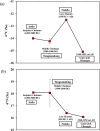Ecological Insights Into the Extinct Korean Sea Lion (Zalophus japonicus) in Korea Based on Stable Isotope Analysis of Bone Collagen
- PMID: 41037025
- PMCID: PMC12490436
- DOI: 10.1002/rcm.10140
Ecological Insights Into the Extinct Korean Sea Lion (Zalophus japonicus) in Korea Based on Stable Isotope Analysis of Bone Collagen
Abstract
Rationale: The Japanese sea lion (Zalophus japonicus), once abundant in Japan, Korea, and Russia, went extinct by the mid-20th century due to hunting and environmental change. This study examines the diet and ecological role of Korean Z. japonicus using stable carbon and nitrogen isotope analysis of bone collagen from archaeological and historical contexts.
Methods: Skeletal remains of the extinct Korean sea lion (Z. japonicus) were excavated from Gajae-gull, Ulleungdo, in 2021. A rib bone was analyzed for radiocarbon dating using AMS and calibrated with the Marine20 curve, applying a ΔR correction. Stable isotope analysis of extracted bone collagen (δ13C, δ15N) was performed via EA-IRMS. Isotopic niches of Z. japonicus and modern marine mammals were compared using SIBER in R, with ANOVA and post hoc tests.
Results: Radiocarbon dating of a rib from Gajae-gull, Ulleungdo, indicated burial between 1548 and 1952 cal ad, representing the most recent evidence of Z. japonicus in Korea. Stable isotope analysis revealed dietary shifts from high δ15N values in the Chulmun periods, indicating consumption of large fish and cephalopods, to lower δ15N and higher δ13C values in the Mumun and historic periods, indicating reliance on coastal mid-trophic prey. Comparisons with modern marine mammals showed clear isotopic niche partitioning.
Conclusions: These findings underscore the dietary flexibility of Korean Z. japonicus and its shifting ecological role in response to changing prey availability and environmental conditions. Future research incorporating additional samples and diverse isotopic markers will enhance paleoecological reconstructions of this extinct species and its historical marine ecosystems.
Keywords: Zalophus japonicus; bone collagen; dietary patterns; stable isotope analysis.
© 2025 The Author(s). Rapid Communications in Mass Spectrometry published by John Wiley & Sons Ltd.
Figures




References
-
- Rice C. W., “Marine Mammals of the World, Systematics and Distributuion,” Society for Marine Mammalogy Special Publication 4 (1998): 1–231.
-
- Jefferson T. A., Webber M. A., and Pitman R., Marine Mammals of the World: A Comprehensive Guide to Their Identification (Elsevier, 2011), 10.1016/B978-0-12-383853-7.X5001-X. - DOI
-
- Ahn S.‐M., “The Emergence of Rice Agriculture in Korea: Archaeobotanical Perspectives,” Archaeological and Anthropological Sciences 2, no. 2 (2010): 89–98.
-
- Kwak S., Kim G., and Lee G.‐A., “Beyond Rice Farming: Evidence From Central Korea Reveals Wide Resource Utilization in the Songgukri Culture During the Late‐Holocene,” Holocene 27, no. 8 (2017): 1092–1102.
-
- Choy K., An D., and Richards M. P., “Stable Isotopic Analysis of Human and Faunal Remains From the Incipient Chulmun (Neolithic) Shell Midden Site of Ando Island, Korea,” Journal of Archaeological Science 39, no. 7 (2012): 2091–2097, 10.1016/j.jas.2012.03.005. - DOI
Publication types
MeSH terms
Substances
Grants and funding
LinkOut - more resources
Full Text Sources
